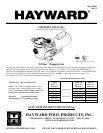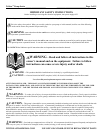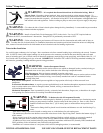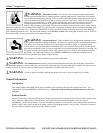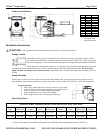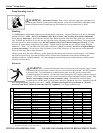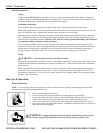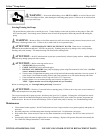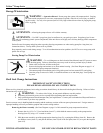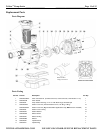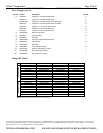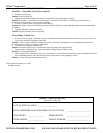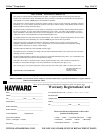
WWW.HAYWARDPOOL.COM USE ONLY HAYWARD GENUINE REPLACEMENT PARTS
TriStar
™
Pump Series ____________________Page 13 of 15
Troubleshooting
Motor Will NOT Start – Check For:
Make sure the terminal board connections agree with the wiring diagram on motor data plate label. Be sure motor is wired
for available field supply voltage (see pump operating label).
1. Improper or loose wiring connections; open switches or relays; tripped circuit breakers, GFCI’s, or blown fuses.
Solution: Check all connections, circuit breakers, and fuses. Reset tripped breakers or replace blown fuses.
2. Manually check rotation of motor shaft for free movement and lack of obstruction.
Solution: Refer to Steps 4 & 5 of “Shaft Seal Change Instructions” in this manual.
3. If you have a timer, be certain it is working properly. Bypass it if necessary.
Motor Shuts OFF – Check For:
1. Low voltage at motor or power drop (frequently caused by undersized wiring or extension cord use).
Solution: Contact qualified professional to check that the wiring gauge is heavy enough.
NOTE: Your Hayward pump motor is equipped with an “automatic thermal overload protector.” The motor will
automatically shut off if power supply drops before heat damage can build up causing windings to burn out. The “thermal
overload protector” will allow the motor to automatically restart once the motor has cooled. It will continue to cut On/Off
until the problem is corrected. Be sure to correct cause of overheating.
Motor Hums, But Does NOT Start – Check For:
1. Impeller jammed with debris.
Solution: Have a qualified repair professional open the pump and remove the debris.
Pump Won't Prime, Check For:
1. Empty pump/strainer housing.
Solution: Make sure pump/strainer housing is filled with water and cover o-ring is clean. Ensure o-ring is properly seated in
the cover o-ring groove. Ensure o-ring sealing surface is lubricated with “Jack’s 327” and that strainer cover is locked firmly
in position. Lubricant will help to create a tighter seal.
2. Loose connections on suction side.
Solution: Tighten pipe/union connections.
NOTE - Any self-priming pump will not prime if there are suction air leaks. Leaks will result in bubbles emanating from
return fittings on pool wall.
3. Leaking O-ring or packing glands on valves.
Solution: Tighten, repair, or replace valves.
4. Strainer basket or skimmer basket loaded with debris.
Solution: Remove strainer housing cover or skimmer cover, clean basket, and refill strainer housing with water. Tighten
cover.
5. Suction side clogged.
Solution: Contact a qualified repair professional.
Block off to determine if pump will develop a vacuum. You should have 5” - 6” of vacuum at the strainer cover (Only your
pool dealer can confirm this with a vacuum gauge). You may be able to check by removing the skimmer basket and
holding your hand over the bottom port with skimmer full and pump running. If no suction is felt, check for line blockage.
a. If pump develops a vacuum, check for blocked suction line or dirty strainer basket. An air leak in the suction
piping may be the cause.
b. If pump does not develop a vacuum and pump has sufficient “priming water”:
i. Re-check strainer housing cover and all threaded connections for suction leaks. Check if all system
hose clamps are tight.
ii. Check voltage to ensure that the motor is rotating at full RPM’s.
iii. Open housing cover and check for clogging or obstruction in suction. Check impeller for debris.
iv. Remove and replace shaft seal only if it is leaking.
Low Flow – Generally, Check For:
1. Clogged or restricted strainer or suction line.
Solution: Contact a qualified repair professional.



